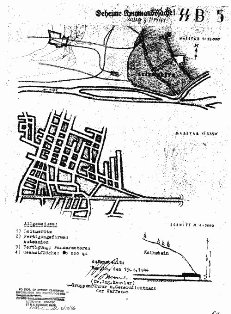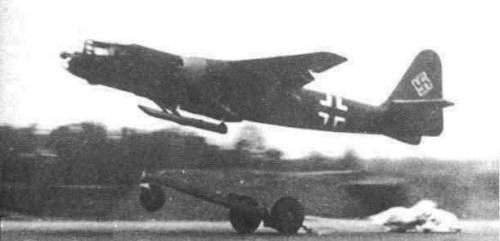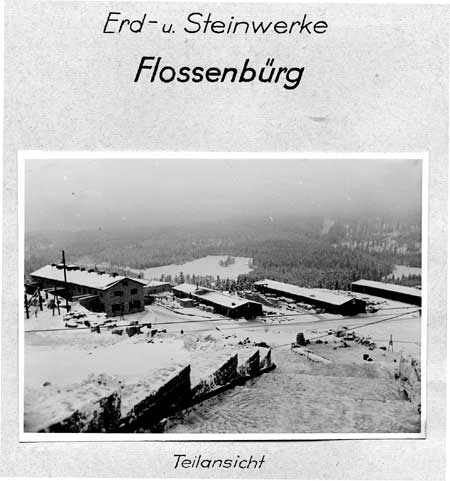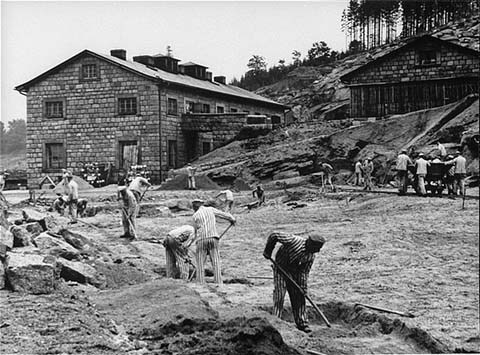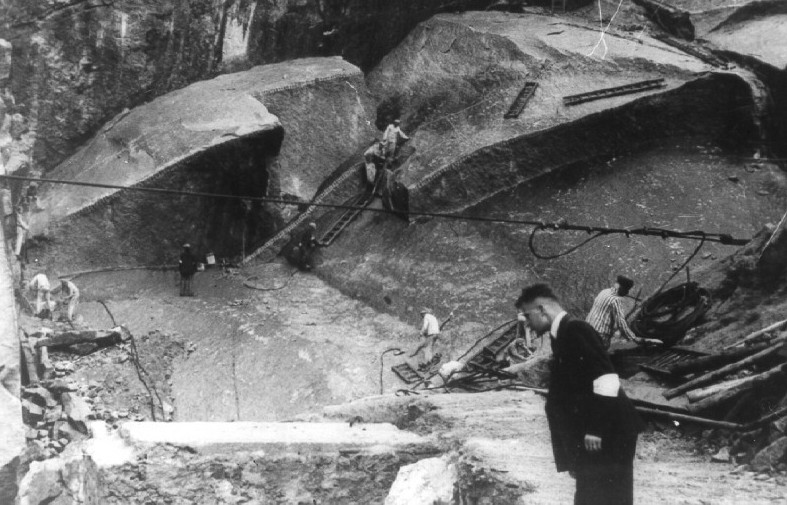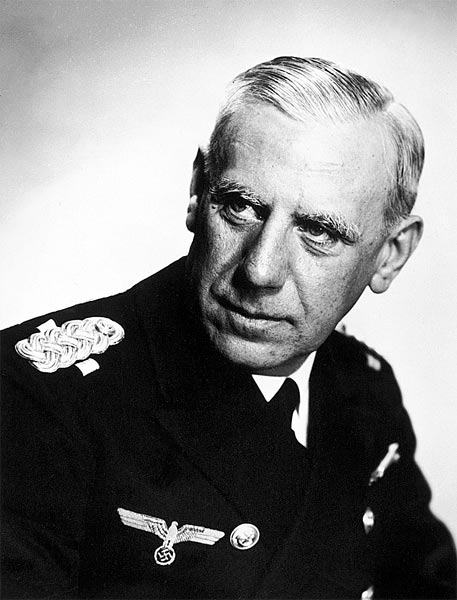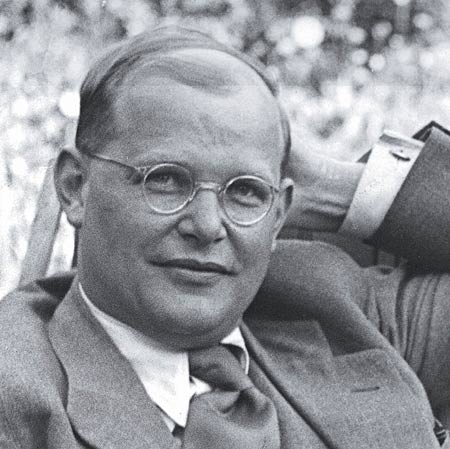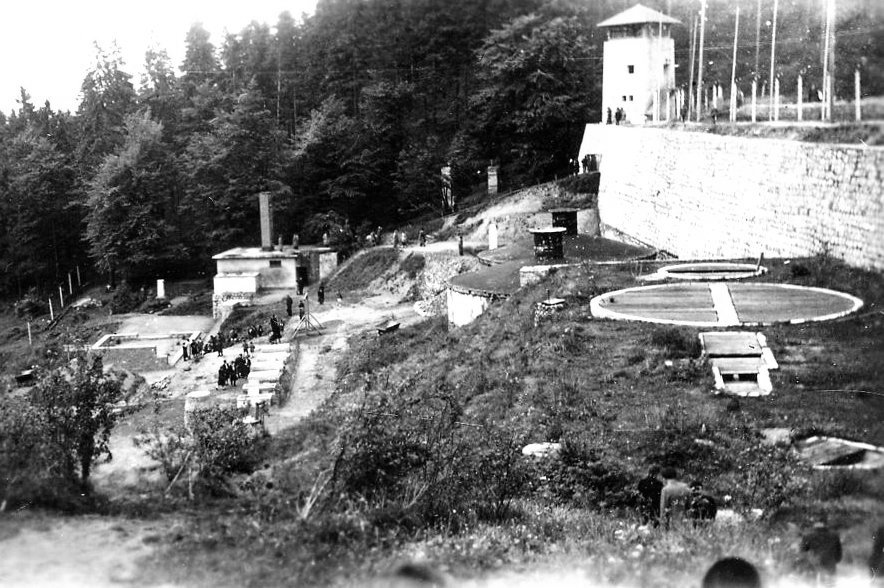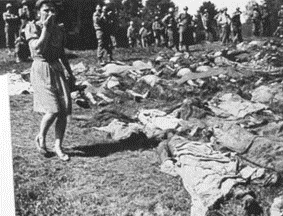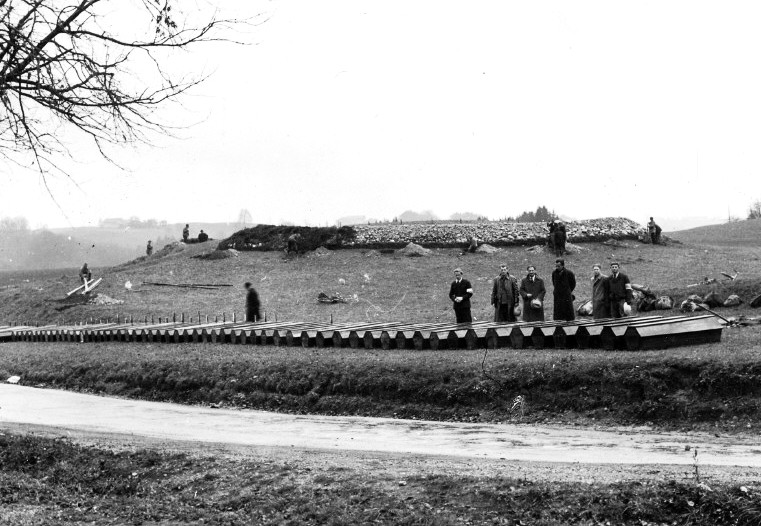Holocaust Education & Archive Research Team |
|
Other Camps
Key Nazi personalities in the Camp System The Labor & Extermination Camps
Auschwitz/Birkenau Jasenovac Klooga Majdanek Plaszow The Labor Camps
Trawniki
Concentration Camps
Transit Camps | |||||||||
Flossenbürg Concentration Camp
The village of Flossenbürg dated from the Middle Ages and was located in the Oberpfalz Mountains of Bavaria, 40 miles east of Nuremburg, near the Czech frontier and situated close to a number of rock quarries. The first granite quarry was established there in 1875 and soon became the center of the village economy.
KL Flossenbürg was established in May 1938, and began as a relatively small facility originally intended for criminals, "asocial" persons, and Jews, but it grew to include political prisoners and foreign prisoners of war. Between 1938, when the camp was established, and April 1945, more than 96,000 prisoners passed through Flossenbürg. About 30,000 eventually died there. The Commandants of Flossenburg were:
Other notable SS men who served at Flossenburg were:
During the war, prisoner forced labor became increasingly important in German arms production. As a result, the Flossenbürg camp system expanded to include approximately 100 sub camps concentrated mainly around armaments industries in southern Germany and western Czechoslovakia.
In 1941-1942, about 1,500 Polish prisoners, mostly members of the Polish resistance, were deported to Flossenbürg. In July 1941, and more than 1,000 Soviet prisoners of war were executed there by the end of 1941. With time the camp expanded, so that by war’s end approximately 94,200 prisoners, including 16,000 females, were imprisoned there or in its numerous sub camps. In addition to German prisoners, inmates included Russian, Polish, French,Czech, Italian, Greek, Danish, Norwegian, British, Canadian, and American nationals, as well as Jews of all nationalities, some Allied prisoners of war (POWs), deserters from the German Armed Forces, and common criminals. Many of the prisoners at Flossenbürg were employed at the Messerschmitt factory that was established within the camp in 1942. The Freiburg sub-camp In Freiberg in December 1943, preparations began for a sub camp of KZ Flossenbürg to house an outside detail at the Arado-Flugzeugwerke (Arado Aircraft Factory). The planning and construction of this housing sub-camp is a clear example of the collaboration between the armaments industry, the SS, and the Ministry of Armaments. The SS approved the application for the allocation of a prisoner work-detail that Arado had submitted within the context of the Jaegerstab's (Fighter Staff's) measures. In its building application, Arado was represented by a building commissioner of the Reich Ministry for Armaments and War Production (RMfRuK) based in Dresden. When the first transport arrived on August 31, 1944, with 249 primarily Polish Jewish women and girls from Auschwitz -- whom the Flossenbürg commandant assigned prisoner numbers 53,423 through 53,671 -- the barracks were not yet complete and the prisoners had to be lodged in the empty halls of a former porcelain factory. The second transport arrived on September 22, 1944, with 251 women from Auschwitz, also primarily Polish Jews, who were assigned prisoner numbers 53,672 through 53,922. The third transport was registered on October 12, 1944, delivering 512 Jewish women and girls -- assigned prisoner numbers 53,923 through 54,435 -- to Freiberg.
This transport included 180 Czechs, 127 Slovaks, 91 Germans, 28 Yugoslavs, 22 Dutch, 15 Hungarians, 6 Poles, 1 Italian, 1 Russian, and 1 American, as well as 21 stateless women and 9 whose nationalities have not yet been determined. 96 women were personally selected at Auschwitz by Dr. Josef Mengele for deportation to Freiberg. He decided who went on the transport, who stayed at the Auschwitz-Birkenau camp, and who was to be murdered immediately. When the female prisoners were transferred to the still unfinished barracks in December 1944, they faced considerably worse living conditions. With bare feet and inadequate clothing, they were forced daily to walk half an hour in deep snow to the factory. Some also had to go to the Hildebrand munitions factory. The cold and wet concrete barracks, the brutality of the SS female guards, the physically draining work, and malnourishment soon claimed the lives of a number of prisoners. Hana L., a Czech prisoner, reported:
The major sub-camps of Flossenbürg were:
Altenhammer, Ansbach, Bayreuth, Bruex, Chemnitz, Dresden, Eisenberg, Floeha, Freiberg, Ganacker, Gieblstadt, Grafenreuth, Graslitz, Gundelsdorf, Hainchen, Heidenau, Helmbrechts, Hersbruck, Hertine, Hohenstein, Holleischen, Holysov, Hradischko, Janowitz, Johanngeorgenstadt, Kirschham, Konigstein, Krondorf, Leitmeritz, Lengenfeld, Mehltheuer, Meissen, Mittweida, Mockethal, Moschendorf, Mulsen, Neu-Rohlau, Nossen, Nurnburg, Obertraubling, Oederan, Plattling, Plauen, Porschdorf, Poschetzau, Pottenstein, Rabstein, Regensburg, Rochlitz, Saal, St. Georgenthal, Schlackenwerth, Schoenheide, Seifhennersdorf, Siegmar, Stein- Schoenau, Stulln, Teichwolframsdorf, Venusberg, Willischthal, Wolkenburg, Wurzburg, Zschachwitz, Zschopau, Zwickau and Zwodau.
One Jewish prisoner described his working in a factory sub –camp:
“At this camp there was a factory that made bazookas. There was one SS man for every four prisoners. Every day 15 men died, aside from those who died from “natural causes.”
We ran to work. Work intended for 20 people was done by 10 – we worked from 6am to 7pm. We collapsed, many people committed suicide. In two weeks 500 died.
Filth - no water - two days without heat - no bath - no underwear. There was twenty-five lashes for stealing potato peelings. They called us the race gang, communists, cadets, soap-bags, criminals and Bolsheviks.
Because things were so bad at the front, they hurried us and always beat us at the factory. To load bazookas we had to use picric acid and trotil. We worked without gas marks, and after a few weeks the lungs and feet would cave in.
The young were chosen for this task. SS men would kill them while they worked, so there was also a shortage of workers.”
Homosexuals at Flossenbürg
The SS considered it great sport to taunt and torture the homosexuals. The camp commander at Flossenbürg often ordered them flogged; as the victims were screaming, he was panting with excitement, and masturbated wildly in his trousers until he came,' unperturbed by the hundreds of onlookers.
Heinz Heger wrote:
On September 1, 1944, Flossenbürg became a training camp for extremely large numbers of female guards Aufseherin who were recruited by force from factories all over Germany and Poland. All together, over 500 women were trained in the camp and in time went on to its subcamps.
Women matrons staffed the Flossenburg sub camps, such as Dresden Ilke Werke, Freiberg, Helmbrechts, Holleischen, Leitmeritz, Mehltheur, Neustadt (near Coburg), Nürnberg-Siemens, Oederan, and Zwodau, and it is known that six SS women staffed the Gundelsdorf subcamp in Czechoslovakia.
Executions of Soviet prisoners of war continued sporadically through 1944. Soviet prisoners of war in Muelsen St. Micheln, a sub-camp of Flossenbürg, staged an uprising and mass escape attempt on May 1, 1944.
They set their bunks on fire and killed some of the camp's Kapos, prisoner trustees who carried out SS orders. SS guards crushed the revolt and none of the prisoners escaped. Almost 200 prisoners died from burns and wounds sustained in the uprising.
The SS transferred about 40 leaders of the revolt to Flossenbürg itself, where they were later murdered in the camp jail.
Among the prisoners sent westward to Flossenbürg in 1944 were inmates of the slave labor camp at Plaszow. Auschwitz also sent many prisoners to Flossenbürg, many of whom died on the deportation trains. One death march lasted 42 days.
On April 9, 1945, shortly before U.S. forces liberated Flossenbürg, the SS executed Admiral Wilhelm Canaris, General Hans Oster, Pastor Dietrich Bonhoeffer, and other persons associated with German resistance groups or implicated in the July 1944 attempt to assassinate Hitler.
The Gestapo arrested Bonhoeffer and Oster in April 1943, and Canaris in the aftermath of the failed attempt to kill Hitler in July 1944. All three were humiliated before the entire camp and then executed on April 9, 1945, a few weeks before the end of the war.
Beginning at the slave labor camp of Neusalz, on 26 January 1945, 1000 Jewish women were sent out toward Flossenbürg. Most died or were murdered along the way, and only 200 survived the march, arriving 11 March - to be promptly shipped on by train to Bergen Belsen.
On 8 April 1945 the remaining Jewish prisoners at Buchenwald were marched toward the camp. Occasionally, trainloads of newly apprehended prisoners also arrived. As late as 14 December 1944 a train departed northern Italy bearing Jews destined for Flossenbürg.
Towards the end of the war as U.S. forces approached the camp, on April 20, 1945, the SS began the forced evacuation of prisoners, except those unable to walk, from the Flossenbürg camp.
About 22,000 prisoners, including 1,700 Jews, were forced on a death march from the main camp toward Dachau in southern Germany. SS guards shot any prisoner too weak or ill to keep up. At least 7,000 prisoners died or were shot before reaching Dachau. The Flossenbürg War Crimes Trial The trials began in Dachau, Germany, on June 12, 1946, and came to an end on January 22, 1947. Forty-six former staff from Flossenbürg concentration camp were tried by an American Military for crimes of murder, torturing, and starving the inmates in their custody. All but five of the defendants were found guilty, fifteen of whom were condemned to death, eleven were given life sentences, and fourteen were jailed for terms of one to thirty years. These crimes also included the executions of Allied Prisoners of War brought from Fresnes prison near Paris, a detailed statement by A. Mottet, a French Resistance member recalls this and his time in Flossenburg.
Sources: NARA T580, Captured German Records Filmed at Berlin (American Historical Association), 1960, rolls 69 and 70. Record Group (RG) 242. NARA Publication Title: Concentration Camp Flossenbürg Inmate Entry Registers, 1938–1945. Heinz Heger The Men with the Pink Triangle Alyson Publications; Revised edition 1994. The United States Holocaust Memorial Museum Encyclopedia of Camps and Ghettos. The Camp Men by French L Maclean published by Schiffer Military History Atglen PA 1999 . Holocaust Historical Society. National Archives Kew
Copyright: Carmelo Lisciotto, Chris Webb, & Sean McConney H.E.A.R.T 2008
|


